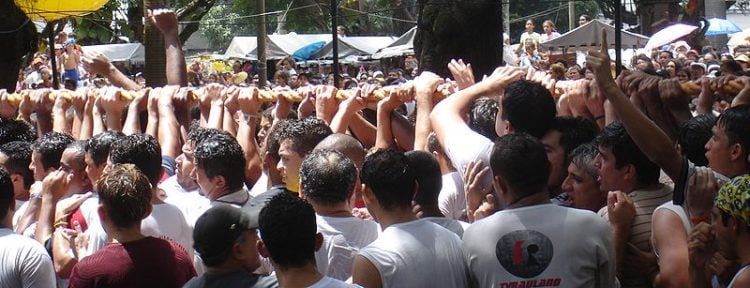Every year, in the second week of October, millions of Roman-Catholic devotees from all over Brazil descend on the city of Belem to attend Cirio de Nazaré, the country’s largest religious festival, and to touch a 400-meter-long piece of rope believed to have the power to heal the sick.
Cirio de Nazaré has been celebrated intermittently in Brazil since 1793. The event revolves around a small statue of Nossa Senhora de Nazaré (Our Lady of Nazareth), an artifact supposedly sculpted in Nazareth that is believed to have performed miracles in medieval Portugal, before being lost in Brazil. Legend has it that a cattleman found it in a canal during the 1700’s, but every time he took it out of the water, it would disappear, only to be found again in the original place it was discovered. The people of Belem believed that it was Our Lady’s wish to remain there, so they built a church there, which would later become today’s Nazaré Basilica.
The celebration lasts two weeks, but the climax of the event is on the first Sunday, when the small statue is taken from the city’s Catedral da Sé to the Nazaré Basilica, on a flower-bedecked carriage pulled by thousands of devotees. The night before the procession about 15.000 devotees queue in front of the cathedral to secure a place near the 400-meter-long piece of rope used to pull the carriage through the city. Men and women align on two separate lines, and by 10 a.m. on Sunday, the human density around the rope reaches an incredible 10 people per meter.

Photo: Osmar Arouck/Wikimedia Commons
As the statue of Nossa Senhora de Nazaré begins its 3.5km journey to Nazaré Basilica, over 2 million people accompany it through the streets, singing to the chants aired by the speakers along the path, to salute the passage of the Virgin. The most devoted of them squirm and and grope to get a hand on the rope pulling the vehicle, and those that are successful struggle to keep their grip. It’s a daunting task, as the procession moves at a snail’s pace, and the high humidity and temperature (often around 40 degrees Celsius) make it hard to breathe.
Fainting is common during the five-to-nine hours it takes for the procession to reach its destination, but volunteers and doctors are always standing by to provide swift medical attention and evacuate sufferers. Getting to them is not the easiest thing in the world, as the area around the rope is so densely packed, that those feeling sick couldn’t escape it even if they wanted to. Many of the barefoot supplicants finish the journey on their knees, with barely enough stamina to keep from passing out. They view the rope as a link between the Saint and her followers, and most of them would rather collapse then let go.
But even as the procession reaches its destination, the devotees don’t loosen their grip one bit. Instead they wait for someone to cut the rope in small pieces, maneuvering the tight space between their hands, so they can keep them as holy souvenirs of their struggle and evidence of their strong faith. The tiniest thread of rope is believed to have miraculous healing powers, and many believers go through this whole ordeal in the hopes of curing themselves or their loved ones of serious health conditions.
This year, the pressure on the rope was so great that it broke halfway through the procession. It is estimated that 8,000 people got the chance to reach it.
Sources: Lonely Planet, Plus55, Valerio Berdini Photography






